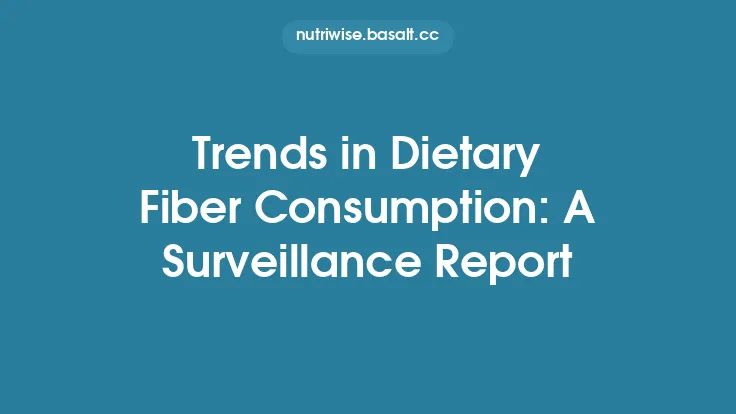Plant‑based diets—ranging from flexitarian patterns that include occasional animal products to fully vegan regimens—have moved from niche lifestyle choices to mainstream dietary options across many continents. Epidemiological surveillance over the past two decades reveals a steady rise in the proportion of individuals who identify as plant‑based eaters, as well as an expansion of the demographic groups that adopt these patterns. This article synthesizes the most robust evidence on the worldwide adoption of plant‑based diets, outlines the methodological tools used to capture these trends, and discusses the implications for public‑health nutrition research.
Global Trajectory of Plant‑Based Diet Adoption
Large‑scale population surveys (e.g., the International Study of Food Consumption, the Global Dietary Database, and national health interview surveys) consistently report upward trajectories in plant‑based diet prevalence. Between 2000 and 2020, the proportion of adults reporting a “mostly plant‑based” diet increased from roughly 5 % to 12 % in high‑income regions, while low‑ and middle‑income countries (LMICs) showed a more modest but accelerating rise from 2 % to 7 %. The steepest gains have been observed in North America, Western Europe, and Oceania, where market data indicate a 30–45 % annual growth in sales of plant‑based meat analogues and dairy alternatives. In contrast, emerging economies in Asia and Africa display a slower but notable shift, driven largely by younger, urbanized cohorts.
Demographic Determinants
*Age*: Younger adults (18–34 years) are the most likely to adopt plant‑based diets, with prevalence rates up to three times higher than those of individuals over 55 years. This age gradient reflects generational differences in health awareness, environmental concerns, and exposure to digital nutrition content.
*Gender*: Women consistently report higher adoption rates than men, a pattern that persists across cultural contexts. Meta‑analyses of cross‑sectional studies estimate a pooled odds ratio of 1.6 (95 % CI 1.4–1.8) for women versus men adopting a plant‑focused diet.
*Education and Income*: Higher educational attainment correlates positively with plant‑based diet adoption, likely due to greater nutrition literacy and access to specialty food products. Income effects are more nuanced; while higher income facilitates purchase of premium plant‑based alternatives, lower‑income groups in some regions adopt plant‑centric meals out of necessity, given the relative affordability of legumes and grains.
*Urban vs. Rural Residence*: Urban dwellers exhibit higher adoption rates, reflecting greater exposure to plant‑based food outlets, media messaging, and peer networks. Rural populations, however, maintain traditional plant‑rich dietary patterns (e.g., pulses, tubers) that may not be captured as “plant‑based” in surveys focused on modern dietary labels.
Motivational Drivers
Epidemiological questionnaires routinely assess motivations for dietary change. The most frequently cited reasons for adopting plant‑based diets include:
- Health Promotion – 68 % of respondents cite disease prevention (cardiovascular health, weight management) as a primary motivator.
- Environmental Sustainability – 45 % express concern about climate change, resource depletion, and animal welfare.
- Ethical Considerations – 38 % prioritize animal rights and humane treatment.
- Taste and Culinary Exploration – 22 % are attracted by novel flavors and cooking techniques.
These motivations often intersect; for instance, individuals motivated by health may also endorse environmental benefits, creating synergistic reinforcement of dietary adherence.
Measurement Approaches in Epidemiology
Capturing plant‑based diet adoption requires nuanced assessment tools:
- Food Frequency Questionnaires (FFQs): Modified FFQs incorporate items specific to plant‑based protein sources (e.g., tofu, tempeh, legumes) and exclude animal products. Validation studies against 24‑hour recalls show correlation coefficients of 0.65–0.78 for plant‑protein intake.
- Dietary Pattern Scores: Indices such as the Plant‑Based Diet Index (PDI) and the Healthful Plant‑Based Diet Index (hPDI) assign positive scores to plant foods and negative scores to animal foods. These scores enable quantification of adherence intensity and facilitate dose‑response analyses with health outcomes.
- Self‑Identification Measures: Direct questions (“Do you consider yourself a vegetarian, vegan, or flexitarian?”) capture identity‑based adoption, which may differ from actual intake patterns. Combining self‑identification with quantitative intake data improves classification accuracy.
- Market and Sales Data: Retail scanner data and import/export statistics provide indirect evidence of consumer demand for plant‑based products, complementing self‑reported intake.
Health Implications Observed in Population Cohorts
Large prospective cohorts (e.g., the Nurses’ Health Study, the EPIC study) have linked higher adherence to plant‑based dietary patterns with reduced incidence of several chronic diseases:
- Cardiovascular Disease (CVD): A pooled relative risk of 0.78 (95 % CI 0.71–0.86) for coronary heart disease among individuals in the highest quintile of PDI.
- Type 2 Diabetes: A 22 % lower risk observed in high‑adherence groups, independent of body mass index.
- Certain Cancers: Modest reductions in colorectal and breast cancer risk have been reported, though heterogeneity across studies persists.
These associations are mediated through multiple pathways, including improved lipid profiles, lower blood pressure, enhanced glycemic control, and reduced systemic inflammation. Importantly, epidemiological analyses adjust for confounders such as physical activity, smoking, and socioeconomic status to isolate the dietary effect.
Nutrient Adequacy and Potential Gaps
While plant‑based diets can meet most macro‑ and micronutrient requirements, epidemiological surveys identify recurring shortfalls:
- Vitamin B12: Deficiency prevalence is higher among strict vegans (up to 30 % in some cohorts) due to the absence of animal‑derived sources.
- Iron and Zinc: Bioavailability is lower in plant foods; women of reproductive age may be at risk for suboptimal status without fortified foods or careful meal planning.
- Omega‑3 Fatty Acids (EPA/DHA): Algal oil supplements are increasingly used, but population data show limited intake among plant‑based adherents.
Public‑health nutrition surveillance now incorporates biomarkers (serum B12, ferritin, plasma DHA) alongside dietary data to monitor these gaps and guide fortification policies.
Policy and Environmental Context
Governments and health agencies have begun to recognize plant‑based diets as part of dietary guidelines. For example, several national dietary guidelines now include “flexitarian” recommendations, encouraging increased consumption of legumes, nuts, and seeds. Subsidies for pulse production, tax incentives for plant‑based food manufacturers, and public procurement policies (e.g., school meals) are emerging as structural levers to support adoption.
Simultaneously, the food industry’s investment in plant‑based product development has accelerated, resulting in a broader array of affordable, culturally adapted options. Epidemiological monitoring of market penetration helps assess whether these innovations translate into sustained dietary change.
Research Gaps and Future Directions
Despite robust evidence of rising adoption, several methodological and substantive gaps remain:
- Longitudinal Tracking: Few studies have followed individuals over multiple decades to assess the durability of plant‑based diet adoption and its long‑term health impact.
- Cultural Adaptation: Most dietary indices are based on Western food patterns; developing culturally sensitive plant‑based diet scores for Asian, African, and Latin American contexts is needed.
- Interaction with Food Systems: Integrating data on agricultural production, supply chain sustainability, and dietary intake will enable a more holistic assessment of the environmental co‑benefits of plant‑based diets.
- Precision Nutrition: Emerging omics technologies (metabolomics, microbiome profiling) offer opportunities to elucidate individual variability in response to plant‑based diets, but large‑scale epidemiological datasets are required to validate these findings.
Conclusion
The epidemiology of plant‑based diet adoption demonstrates a clear, worldwide upward trend driven by health, environmental, and ethical motivations. Demographic analyses reveal that younger, educated, and urban populations are leading this shift, while market data confirm expanding availability of plant‑based foods. Robust measurement tools—ranging from refined dietary questionnaires to biomarker surveillance—allow researchers to quantify adherence and link it to favorable health outcomes, albeit with attention to potential nutrient gaps. Policy initiatives that align food‑system incentives with plant‑based dietary patterns are beginning to reinforce these trends. Continued longitudinal research, culturally tailored assessment methods, and integration of environmental metrics will be essential to fully understand and support the global transition toward more plant‑centric nutrition.





